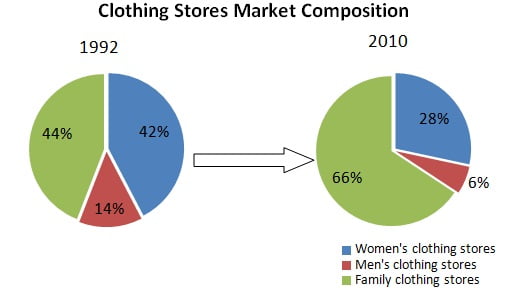Do you know that Departmental stores are being replaced by Warehouse clubs and Super stores? It’s true. Look at the market share composition (market share graph below), it is clearly visible that merchandise industry has evolved from Departmental stores dominant (73% to 28%) to Warehouse clubs and Super stores dominant (17% to 72%) industry. It means people preference has changed from Departmental stores to Warehouse clubs and Super stores.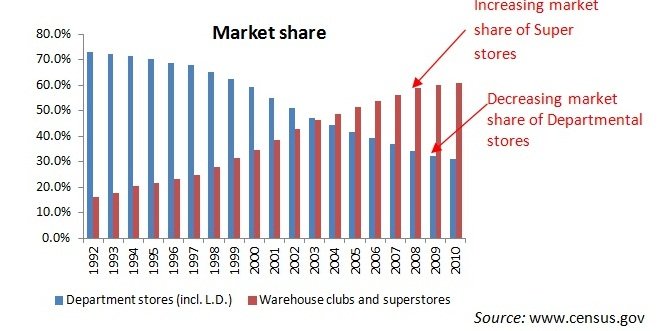
Some may argue that it is because Warehouse clubs and Super stores are growing rapidly than Departmental stores but it is just not that,Warehouse clubs and Super stores are also taking away Departmental stores sales. If we examine yearly sales, the Departmental stores sales are in decreasing trend from 2000 while the total Merchandise industry sales and ‘Warehouse club and Super stores’ sales are growing implying Warehouse clubs and Super stores are eating away Departmental stores sales. 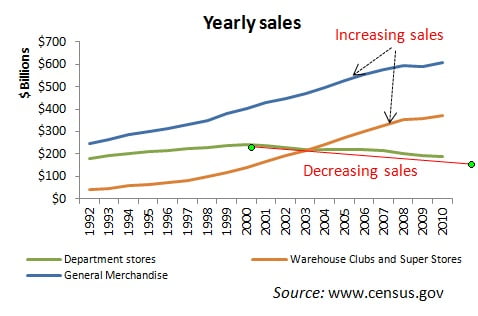 In addition to that from 1997 to 2007 numbers of warehouse club and super stores have increased by 178% while Departmental stores have decreased by 18%. The facts that numbers of Super stores are increasing and sales of Departmental stores are decreasing indicate that Warehouse clubs and Super stores are replacing Departmental stores.
In addition to that from 1997 to 2007 numbers of warehouse club and super stores have increased by 178% while Departmental stores have decreased by 18%. The facts that numbers of Super stores are increasing and sales of Departmental stores are decreasing indicate that Warehouse clubs and Super stores are replacing Departmental stores.
Alcohol No Longer a Luxury!
Beer, Wine and Liquor are no longer luxury goods. They have become more of basic goods. Look at the sales during dot-com bubble and the recent recession, sales have increased slightly instead of decreasing. This means people are not treating beer, wine and liquor as luxury which is the reason for not postponing their consumption of alcohol to save money during recession. Alongside if we observe sales during 1991-2010 they have increased from $21 billion to $42 billion, a 100% increase, at a steady rate without any sudden peaks and troughs – implying it is not much affected by by economic changes.
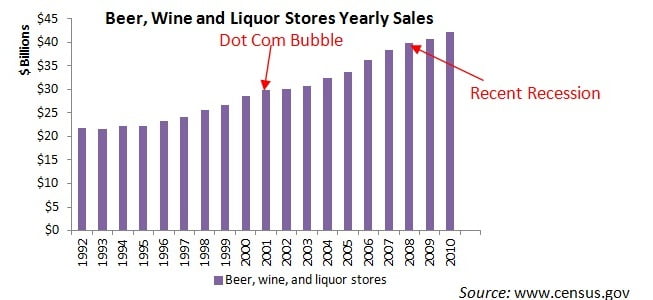
Sports Habits Die Hard
It is surprising that, even during recession people tend to keep up with their sports habits. According to US census data sporting goods sales have increased from $35 billion to $37 billion during recent recession.

From the above graph, it is also evident that sales growth is never negative indicating that Sports goods stores sales have never declined majorly. In addition to that, during recession sports goods stores sales has grown more than GDP in 2008 and maintained the sales i.e., 0% growth till 2009 end. This implies that even during recession people tend to keep up with their sports habits even though they may not take new ones.
No to Exclusive stores; Welcome Family Stores
Buy for everyone in a single trip seems to be new mantra in clothing industry. More People started to prefer family stores to exclusive stores. Look the transformation of market share of clothing industry from 1992 to 2010:
The market share composition of clothing industry show that Family clothing stores market share has increased (from 44% to 66%) while the market share of women’s and men’s clothing stores has decreased (from 42% to 28% and 14% to 6% respectively) – a change in preference. The Compound Annual Growth Rate (CAGR) of Men’s clothing stores, Women’s Clothing stores and Family Clothing stores are -1.5%, 0.83% and 5.42% respectively. The facts that increasing market share and high CAGR implies that people are shifting their preference from exclusive stores to Family clothing stores.
Let us dissect further and look who among men’s stores and women’s stores are affected more.
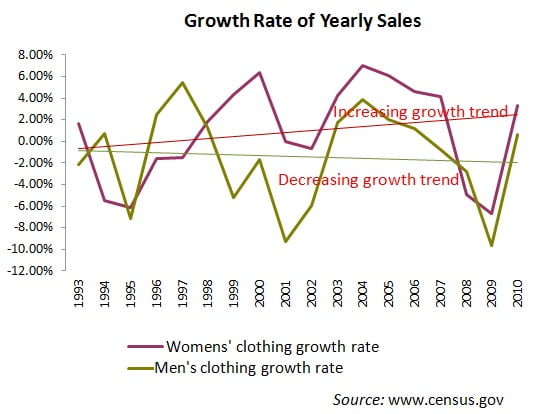 Men’s clothing stores are majorly affected by family stores than women’s clothing stores. According to US Census data Men’s Clothing stores sales have decreased from $10 billion to $7 billion from 1992 – 2010 while women’s clothing stores sales have increased from $31 billion to $36 billion during the same period. In addition to that the growth rate trend of men’s clothing stores is decreasing while that of women’s clothing stores is increasing. This shows that men’s clothing stores with decreasing sales and sales growth are largely affected by family stores than women’s clothing stores. But something interesting is happening with women’s clothing stores sales, even though sales are growing its market share is decreasing, it means family stores are not replacing women’s clothing they are just growing more than women’s clothing stores while on the other hand in men’s clothing stores case family stores are replacing their sales.
Men’s clothing stores are majorly affected by family stores than women’s clothing stores. According to US Census data Men’s Clothing stores sales have decreased from $10 billion to $7 billion from 1992 – 2010 while women’s clothing stores sales have increased from $31 billion to $36 billion during the same period. In addition to that the growth rate trend of men’s clothing stores is decreasing while that of women’s clothing stores is increasing. This shows that men’s clothing stores with decreasing sales and sales growth are largely affected by family stores than women’s clothing stores. But something interesting is happening with women’s clothing stores sales, even though sales are growing its market share is decreasing, it means family stores are not replacing women’s clothing they are just growing more than women’s clothing stores while on the other hand in men’s clothing stores case family stores are replacing their sales.

